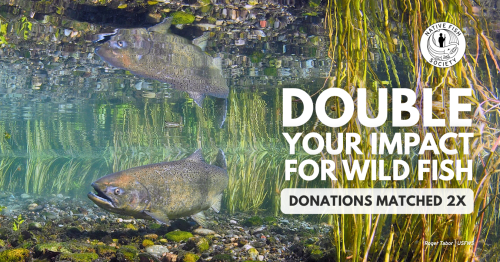Wild salmon and steelhead have a 15 million year history in our landscape. Locally adapted to their home rivers salmon are an expression of rock, water, erosion, forests and weather. They are the primary indicator of the health of our Northwest environment.
The Pacific Northwest once produced more wild, native salmon, steelhead and trout than
just about anywhere on the planet. Millions
of these remarkable
fish returned from the Pacific to climb our
region's vast and free flowing rivers on their annual migration
to spawning grounds that historically stretched as far inland as Montana
and Nevada. Salmon adapted to short and temperate coastal
streams. They also found their
way 700 miles inland to elevations over 10,000ft dominating wilderness streams
tucked high in Idaho's Rocky
Mountains. The Northwest is a land shaped by and constantly shaping the
populations and characteristics of wild, native fish. Wild, native
fish are defined by their direct relationship with their
habitats.
Today, the number of Northwest stream miles available to wild salmon, steelhead and trout has shrunk dramatically. For example, salmon and steelhead returning to the Columbia River Basin (a watershed roughly the size of France) have lost nearly 50% of their historically available habitat ( McClure, 2008). Massive changes to our watersheds have occurred piecemeal, one cut at a time. Snow fed headwaters have been obstructed by dams, sprawling cities stand where once old marshes and wetlands existed, logging has changed the age, diversity, and makeup of our forests, agriculture has diked, drained and constrained our rivers, and development has hardened river banks and removed streamside vegetation. Roads crisscross and divide throughout. With the loss of their habitat salmon have also declined, with more than 50% of the original populations of the Northwest either extinct or threatened with extinction ( Gustafson, 2007).
Within the constellation of organizations addressing habitat issues, the Native Fish Society's niche is working with local place-based advocates to steward the habitats that sustain their local wild, native fish populations. When working to address habitat, our steward's primary focus is protecting the intact habitats that remain in their watersheds. As the old adage goes, an ounce of prevention is worth a pound of cure. Often, a grassroots campaign to protect salmon habitat costs a mere fraction of the capital necessary to restore already degraded habitats.
Habitat protection requires advocacy and local River Stewards empowered with the best-available science are among the best possible advocates for protecting habitats. For example, on Oregon's Northern Coast stewards have joined forces with the members of the North Coast State Forest Coalition urging Oregon to create larger streamside buffers and set aside portions of the state's forest for conservation. River Stewards on the Molalla and Chetco rivers recently protected 28 river miles from future damming, dewatering and mining through Oregon's State Scenic Waterways Program. South Umpqua River Steward, Stan Petrowski worked tirelessly to protect his watershed and over 24,000 Oregon stream miles from suction dredge mining. In Southwest Oregon, River Stewards Dave Lacey, James Smith and Sunny Bourdon are working as part of the Wild Rivers Campaign to safeguard 100,000 acres of public lands from the threat of nickel strip mining.
River Stewards also work with habitat restoration partners to promote restoration projects that would create the greatest positive impact for wild, native fish. Ideally, these projects focus on restoring the natural processes that create and sustain high quality fish habitat. For example, Siletz River Steward Matt Lund is working with the Siuslaw Forest Service and the local watershed council on Oregon’s central coast to replace an old culvert currently obstructing 13 miles high quality habitat in North Creek. Once fish passage is reestablished, North Creek’s cold water, clean gravels and large trees will continue creating and sustaining wild, native fish populations, without additional intervention. By partnering with conservation entities that specialize in habitat restoration wild, native fish benefit from our River Steward's place based knowledge and careful understanding of the needs of their wild, native fish populations.
With a grassroots focus on habitat protection, while collaborating on habitat restoration, the Native Fish Society and our River Stewards provide a critical place-based element within the region-wide effort to create a net gain of diverse and functional habitats for wild, native fish.

